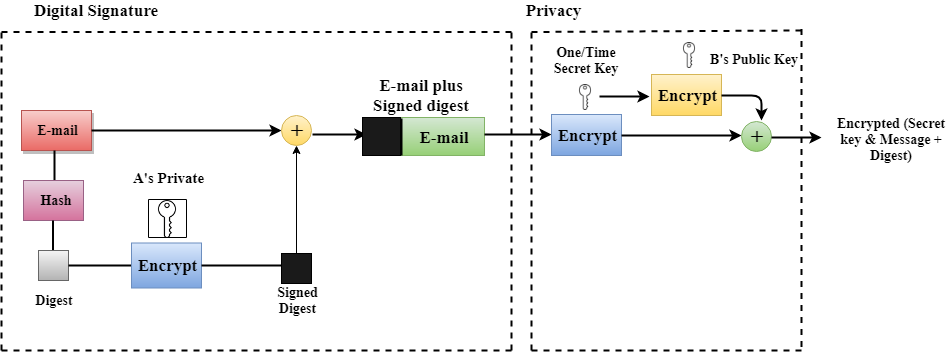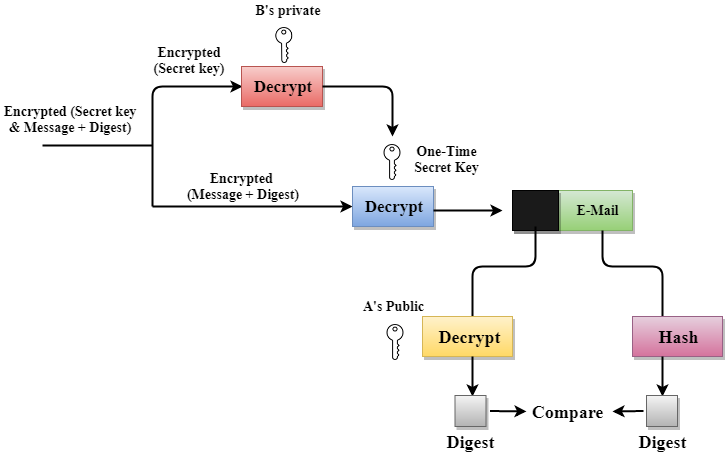Tutorial
Physical Layer
Data Link layer
Network Layer
Routing Algorithm
Transport Layer
Application Layer
Network Security
Misc
- Router
- OSI vs TCP/IP
- TCP vs UDP
- Transmission Control Protocol
- TCP port
- IPv4 vs IPv6
- ARP Packet Format
- ARP Table
- Working of ARP
- FTP Client
- FTP Commands
- FTP Server
- I2C Protocol
- Sliding Window Protocol
- SPI Protocol
- IP
- ARP Commands
- ARP
- Address Resolution Protocol
- ARP and its types
- TCP Retransmission
- CAN protocol
- HTTP Status Codes
- HTTP vs HTTPS
- RIP Protocol
- UDP Protocol
- ICMP Protocol
- MQTT protocol
- OSPF Protocol
- Stop and Wait Protocol
- IMAP Protocol
- POP Protocol
- CIFS
- DAS
- DIMM
- iSCSI
- NAS (Network Attached Storage)
- NFS
- NVMe
- SAN
- Border Gateway Protocol
- Go-Back-N ARQ
- RJ Cable
- Difference between Connection-Oriented and Connectionless Service
- CDMA vs. GSM
- What is MAC Address
- Modem vs. Router
- Switch Vs. Router
- USB 2.0 vs 3.0
- Difference between CSMA CA and CSMA CD
- Multiple access protocol- ALOHA, CSMA, CSMA/CA and CSMA/CD
- URI vs URL
- IMAP vs. POP3
- SSH Meaning| SSH Protocol
- UTP vs STP
- Status Code 400
- MIME Protocol
- IP address
- proxy server
- How to set up and use a proxy server
- network security
- WWW is based on which model
- Proxy Server List
- Fundamentals of Computer Networking
- IP Address Format and Table
- Bus topology and Ring topology
- Bus topology and Star topology
- Circuit Switching and Packet switching?
- Difference between star and ring topology
- Difference between Router and Bridge
- TCP Connection Termination
- Image Steganography
- Network Neutrality
- Onion Routing
- Adaptive security appliance (ASA) features
- Relabel-to-front Algorithm
- Types of Server Virtualization in Computer Network
- Access Lists (ACL)
- What is a proxy server and how does it work
- Digital Subscriber Line (DSL)
- Operating system based Virtualization
- Context based Access Control (CBAC)
- Cristian's Algorithm
- Service Set Identifier (SSID)
- Voice over Internet Protocol (VoIP)
- Challenge Response Authentication Mechanism (CRAM)
- Extended Access List
- Li-fi vs. Wi-fi
- Reflexive Access List
- Synchronous Optical Network (SONET)
- Wifi protected access (WPA)
- Wifi Protected Setup (WPS)
- Standard Access List
- Time Access List
- What is 3D Internet
- 4G Mobile Communication Technology
- Types of Wireless Transmission Media
- Best Computer Networking Courses
- Data Representation
- Network Criteria
- Classful vs Classless addressing
- Difference between BOOTP and RARP in Computer Networking
- What is AGP (Accelerated Graphics Port)
- Advantages and Disadvantages of Satellite Communication
- External IP Address
- Asynchronous Transfer Mode (ATM)
- Types of Authentication Protocols
- What is a CISCO Packet Tracer
- BOOTP work
- Subnetting in Computer Networks
- Mesh Topology Advantages and Disadvantages
- Ring Topology Advantages and Disadvantages
- Star Topology Advantages and Disadvantages
- Tree Topology Advantages and Disadvantages
- Zigbee Technology-The smart home protocol
- Network Layer in OSI Model
- Physical Layer in OSI Model
- Data Link Layer in OSI Model
- Internet explorer shortcut keys
- Network Layer Security | SSL Protocols
- Presentation Layer in OSI Model
- Session Layer in OSI Model
- SUBNET MASK
- Transport Layer Security | Secure Socket Layer (SSL) and SSL Architecture
- Functions, Advantages and Disadvantages of Network Layer
- Protocols in Noiseless and Noisy Channel
- Advantages and Disadvantages of Mesh Topology
- Cloud Networking - Managing and Optimizing Cloud-Based Networks
- Collision Domain and Broadcast Domain
- Count to Infinity Problem in Distance Vector Routing
- Difference Between Go-Back-N and Selective Repeat Protocol
- Difference between Stop and Wait, GoBackN, and Selective Repeat
- Network Function Virtualization (NFV): transforming Network Architecture with Virtualized Functions
- Network-Layer Security | IPSec Modes
- Next - Prev Network-Layer Security | IPSec Protocols and Services
- Ping vs Traceroute
- Software Defined Networking (SDN): Benefits and Challenges of Network Virtualization
- Software Defined Networking (SDN) vs. Network Function Virtualization (NFV)
- Virtual Circuits vs Datagram Networks
- BlueSmack Attack in Wireless Networks
- Bluesnarfing Attack in Wireless Networks
- Direct Sequence Spread Spectrum
- Warchalking in Wireless Networks
- WEP (Wired Equivalent Privacy)
- Wireless security encryption
- Wireless Security in an Enterprise
- Quantum Networking
- Network Automation
- Difference between MSS and MTU
- What is MTU
- Mesh Networks: A decentralized and Self-Organizing Approach to Networking
- What is Autonomous System
- What is MSS
- Cyber security & Software security
- Information security & Network security.
- Security Engineer & Security Architect
- Protection Methods for Network Security
- Trusted Systems in Network Security
- What are Authentication Tokens in Network security
- Cookies in Network Security
- Intruders in Network Security
- Network Security Toolkit (NST) in virtual box
- Pivoting-Moving Inside a Network
- Security Environment in Computer Networks
- Voice Biometric technique in Network Security
- Advantages and Disadvantages of Conventional Testing
- Difference between Kerberos and LDAP
- Cyber security and Information Security
- GraphQL Attacks and Security
- Application Layer in OSI Model
- Applications of Remote Sensing
- Seven Layers of IT Security
- What is Ad Hoc TCP
- What is Server Name Indication(SNI)
PGP
- PGP stands for Pretty Good Privacy (PGP) which is invented by Phil Zimmermann.
- PGP was designed to provide all four aspects of security, i.e., privacy, integrity, authentication, and non-repudiation in the sending of email.
- PGP uses a digital signature (a combination of hashing and public key encryption) to provide integrity, authentication, and non-repudiation. PGP uses a combination of secret key encryption and public key encryption to provide privacy. Therefore, we can say that the digital signature uses one hash function, one secret key, and two private-public key pairs.
- PGP is an open source and freely available software package for email security.
- PGP provides authentication through the use of Digital Signature.
- It provides confidentiality through the use of symmetric block encryption.
- It provides compression by using the ZIP algorithm, and EMAIL compatibility using the radix-64 encoding scheme.
Following are the steps taken by PGP to create secure e-mail at the sender site:
- The e-mail message is hashed by using a hashing function to create a digest.
- The digest is then encrypted to form a signed digest by using the sender's private key, and then signed digest is added to the original email message.
- The original message and signed digest are encrypted by using a one-time secret key created by the sender.
- The secret key is encrypted by using a receiver's public key.
- Both the encrypted secret key and the encrypted combination of message and digest are sent together.
PGP at the Sender site (A)

Following are the steps taken to show how PGP uses hashing and a combination of three keys to generate the original message:
- The receiver receives the combination of encrypted secret key and message digest is received.
- The encrypted secret key is decrypted by using the receiver's private key to get the one-time secret key.
- The secret key is then used to decrypt the combination of message and digest.
- The digest is decrypted by using the sender's public key, and the original message is hashed by using a hash function to create a digest.
- Both the digests are compared if both of them are equal means that all the aspects of security are preserved.
PGP at the Receiver site (B)

Disadvantages of PGP Encryption
- The Administration is difficult: The different versions of PGP complicate the administration.
- Compatibility issues: Both the sender and the receiver must have compatible versions of PGP. For example, if you encrypt an email by using PGP with one of the encryption technique, the receiver has a different version of PGP which cannot read the data.
- Complexity: PGP is a complex technique. Other security schemes use symmetric encryption that uses one key or asymmetric encryption that uses two different keys. PGP uses a hybrid approach that implements symmetric encryption with two keys. PGP is more complex, and it is less familiar than the traditional symmetric or asymmetric methods.
- No Recovery: Computer administrators face the problems of losing their passwords. In such situations, an administrator should use a special program to retrieve passwords. For example, a technician has physical access to a PC which can be used to retrieve a password. However, PGP does not offer such a special program for recovery; encryption methods are very strong so, it does not retrieve the forgotten passwords results in lost messages or lost files.


